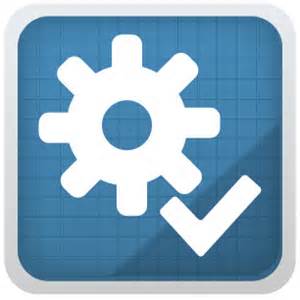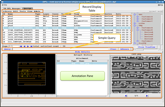YA-DPL (Defect Pattern Library)

Design or layout hotspots are a common fact of life in all current technology nodes. Also known as Patterns of Interest or POI, these hotspots are discovered through several means such as OPC simulation, FEM / PWQ, regular inline inspection, electrical fault diagnostics, and Physical Failure Analysis (PFA).
Unfortunately, these means of discovery are owned by different groups in the Fab, and often there is no easy way to capture, share, and update the status of these hotspots to the benefit of all groups.
To solve this problem, Anchor has developed YA-DPL (Defect Pattern Library) with multi-user support to enhance collaboration across teams.
YA-DPL is a central database of hotspots. This database is accessible to multiple teams across the fab, allowing all authorized team members to add new entries to the database, view and annotate hotspots, and manage the status of those hotspots.
For example, a newly discovered hotspot may be added to the database with supporting metadata that describes the nature of the hotspot in more detail. And the status of the hotspot may be set to ‘active’. Eventually, the root cause of this hotspot may be found and fixed, in which case the status may be downgraded to ‘obsolete’.
Because a relational database stands behind YA-DPL, any user can query for all newly discovered hotspots and view the shape (layout) and image (SEM), if present. Users can also invoke pattern search directly from YA-DPL to find both exact matches and ‘similar’ matches across the die.
When multiple users are involved, there is an increased likelihood for ‘noise’ to enter the system. To guard against noise and corruption of the database, a DPL Administrator is responsible for accepting or rejecting new entries, and for making changes to the status of hotspots. This ensures long term quality of the database.
Unfortunately, these means of discovery are owned by different groups in the Fab, and often there is no easy way to capture, share, and update the status of these hotspots to the benefit of all groups.
To solve this problem, Anchor has developed YA-DPL (Defect Pattern Library) with multi-user support to enhance collaboration across teams.
YA-DPL is a central database of hotspots. This database is accessible to multiple teams across the fab, allowing all authorized team members to add new entries to the database, view and annotate hotspots, and manage the status of those hotspots.
For example, a newly discovered hotspot may be added to the database with supporting metadata that describes the nature of the hotspot in more detail. And the status of the hotspot may be set to ‘active’. Eventually, the root cause of this hotspot may be found and fixed, in which case the status may be downgraded to ‘obsolete’.
Because a relational database stands behind YA-DPL, any user can query for all newly discovered hotspots and view the shape (layout) and image (SEM), if present. Users can also invoke pattern search directly from YA-DPL to find both exact matches and ‘similar’ matches across the die.
When multiple users are involved, there is an increased likelihood for ‘noise’ to enter the system. To guard against noise and corruption of the database, a DPL Administrator is responsible for accepting or rejecting new entries, and for making changes to the status of hotspots. This ensures long term quality of the database.
Centralized Knowledge Capture and Sharing
YA-DPL provides the infrastructure for Fab-wide capture and sharing of hotspot patterns. Hotspots that are discovered by one team can be captured and stored in one place, then shared by all teams across the Fab. In this way, new yield impacting discoveries made by any group can benefit all groups and allow them to collaborate in the resolution process.
Curated Database
When multiple users and multiple teams across the Fab are involved, there is an increased likelihood of noise (junk patterns) and corruption that can reduce the overall value of the central pattern database. To guard against this, a DPL Administrator role is created whose responsibilities include:
- Create DPL Database.
- Define Database Columns.
- Accept or Reject New Entries.
- Delete Database Records.
- Mark Entries as ‘Obsolete’ or ‘Active’.
Invoke Pattern Search Directly
One of the most common operations on newly discovered hotspots is to run a full-die search for both (a) exact matches and (b) similar matches. This allows several types of follow-up actions to take place, four of which are mentioned below.
- Creating a ‘ghost defect KLARF’ containing the locations of a sampled subset of the matching locations. SEM images are taken at these locations to determine the extent of the problematic pattern.
- Creating new care areas for inline inspection in order to ensure that the hotspot locations are monitored more closely.
- Calculating the defective rate for the hotspot, which is the number of hotspots with defects divided by the total number of hotspot locations.
- Determining if the hotspot pattern lies along the path of a failed ‘net’ identified by electrical fault diagnostics.
Annotation
All users have the ability to annotate hotspot records in the database. Annotation is the primary means of collaboration as users from disparate teams contribute their assessment of the root cause or significant of the hotspot. This becomes a ‘conversation thread’ for the hotspot that can be viewed by all users.
Simple or Advanced Queries
Queries are an important part of YA-DPL. Users may wish to find all hotspots added in the last week or last month, or only the hotspots from Front End of Line (FEOL) layers for the 14nm technology node, or only hotspots that are associated with an open or short defect, etc. YA-DPL provides both simply keyword-based queries and more complex structured queries.
Main Benefits:
- YA-DPL provides a central infrastructure for capturing and sharing of newly discovered hotspots across the Fab.
- Multi-user capability allows individuals from multiple teams across the Fab to contribute and collaborate.
- DPL Administrator guards against the injection of noise and corruption in to the database. This leads to a ‘curated’ database that enhances its value over time.
- Various pattern search engines can be invoked directly from within YA-DPL to streamline one of the most common operations on hotspots. NOTE: Pattern Search engines are licensed separately.
Main Features:
- Central hotspot knowledge capture and sharing database that can be access by users across the Fab.
- Database table is highly customizable. DPL Administrator can create just the data columns that are needed.
- All users can submit new patterns to the database. These patterns are placed into an Inbox until the DPL Administrator accepts or rejects them.
- All users can annotate hotspots and invoke pattern search. NOTE: Pattern Search engines are licensed separately.

Technical Requirements
The minimum system requirements are listed below:
- Linux 2.6 or later, 64-bit, x86 based processor.
- 16 or more physical cores.
- 128 GB or more physical memory.
- 2 TB or more available hard drive capacity.




